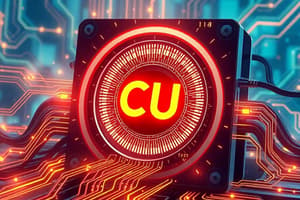Podcast
Questions and Answers
What does CPU speed refer to?
What does CPU speed refer to?
- The brand of the CPU
- The size of the CPU
- How fast a CPU can process instructions (correct)
- How many tasks a CPU can handle simultaneously
What is the primary difference between a video card and on-board video?
What is the primary difference between a video card and on-board video?
- On-board video is faster than a video card
- Video card handles graphics processing, on-board video does not (correct)
- Video card is integrated into the motherboard, on-board video is a separate component
- On-board video requires a license, video card does not
What type of slot is commonly used for video cards?
What type of slot is commonly used for video cards?
- HDMI slot
- USB slot
- VGA slot
- PCI Express (PCIe) slot (correct)
What type of slot is used for adding expansion cards?
What type of slot is used for adding expansion cards?
What is a common problem faced when taking apart and reassembling a computer?
What is a common problem faced when taking apart and reassembling a computer?
What defines Open Source software?
What defines Open Source software?
What is the main function of system software?
What is the main function of system software?
Which type of network does not require a central server for communication?
Which type of network does not require a central server for communication?
What type of device connects multiple devices on a network and manages data traffic between them?
What type of device connects multiple devices on a network and manages data traffic between them?
Which type of cable uses light to transmit data over long distances?
Which type of cable uses light to transmit data over long distances?
What is the purpose of encryption protocols like WEP, WPA, and WPA2 in networking?
What is the purpose of encryption protocols like WEP, WPA, and WPA2 in networking?
Which of the following defines MAN (Metropolitan Area Network)?
Which of the following defines MAN (Metropolitan Area Network)?
Flashcards are hidden until you start studying
Study Notes
CPU and Video Cards
- CPU speed refers to how fast it can process instructions, and faster CPUs can handle more tasks in less time.
- A video card is a separate hardware component that is added to a computer to handle graphics processing, while on-board video is integrated directly into the motherboard.
- PCI Express (PCIe) slots are commonly used for video cards.
Expansion Slots and RAM
- PCI (Peripheral Component Interconnect) slots are used for adding expansion cards.
- To install computer memory (RAM), align the memory module with the slot on the motherboard and firmly press it down until it clicks into place.
Software and Networking Basics
- Open Source software is software whose source code is freely available for anyone to view, modify, and distribute.
- Proprietary software is owned by a specific company or individual, and its source code is not freely available.
- System software manages the computer's hardware and provides a platform for running application software, while application software performs specific tasks for the user.
- A computer network is a group of computers and other devices connected together to share resources and communicate with each other.
Networking Concepts
- A data link is a connection between two devices that allows them to exchange data.
- A node is any device connected to a network, such as a computer or printer.
- LAN (Local Area Network) covers a small geographic area, MAN (Metropolitan Area Network) covers a larger area like a city, and WAN (Wide Area Network) covers the largest area, often spanning across countries or continents.
- In a Peer-to-Peer Network, devices communicate directly with each other without the need for a central server.
- In a Client-Server Network, client devices request services or resources from a central server, which manages and provides those resources.
Network Setup and Security
- Setting up a home network involves connecting devices like computers, printers, and routers together using Ethernet cables or Wi-Fi, and configuring network settings to enable communication and resource sharing.
- WEP, WPA, WPA2 are types of encryption protocols used to secure wireless networks.
- Firewalls are software or hardware devices that monitor and control incoming and outgoing network traffic to protect against unauthorized access.
Networking Hardware and Cables
- Switches are devices that connect multiple devices on a network and manage data traffic between them.
- Bridges connect two separate network segments.
- Gateways connect different types of networks together, such as connecting a LAN to the internet.
- Different types of cables include Ethernet cables for wired connections, HDMI cables for audio and video signals, and USB cables for connecting peripherals like printers and external hard drives.
- Fibre Optic cables use light to transmit data and offer high-speed and reliable communication over long distances.
Studying That Suits You
Use AI to generate personalized quizzes and flashcards to suit your learning preferences.




